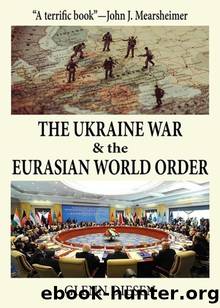The Ukraine War & the Eurasian World Order by Glenn Diesen

Author:Glenn Diesen [Diesen, Glenn]
Language: eng
Format: epub
Tags: Political Science, Geopolitics, World, Russian & Soviet
ISBN: 9781949762952
Google: 1MD1EAAAQBAJ
Amazon: 1949762955
Publisher: Clarity Press
Published: 2024-02-14T23:00:00+00:00
The Russian Empire and the Soviet Union
The contested narrative of Kievan Rus has produced conflicting interpretations of the history that followed. Did the alignment of Galicia-Volhynia with Poland and Lithuania represent a continuation of Kievan Rus, or was it PolishâLithuanian expansionism that divided the peoples of Kievan Rus? Was the Treaty of Pereyaslav in 1654 between the Cossacks and the Tsar a Russian annexation of Ukraine, or was it a reunification of the fraternal peoples of Russia and Ukraine? Did the following three centuries of living in the same state constitute imperialism that Russified Ukraine, or did it become a common history of one people living together as one nation?
During the Second World War, Hitler established a partnership with Stepan Bandera and the fascist Organisation of Ukrainian Nationalists (OUN). Should Bandera and OUN be condemned as fascists who committed genocide against Jews, Poles and Russians, or were they freedom fighters? In Western Ukraine, there are groups who commemorate and mourn the 9th of May as a continuation of Russian domination, while in Eastern Ukraine the 9th of May is celebrated as the Soviet Unionâs victory day over the Nazis. Should Soviet history be celebrated for its achievements or condemned as Russian occupation? Post-Soviet Ukraine struggled to answer these questions as they were so divisive.
The dilemma arose insofar as a common historical narrative is imperative for nation-building, yet strategic ambiguity was necessary to prevent divisions and civil war. Case in point, the history of the Great Famine of 1932â1933, or Holodomor, resulted in millions of deaths. The famine killed Ukrainians, Russians, and other peoples of the Soviet Union, although the overwhelming majority of victims were Ukrainians. A pervasive narrative among the Ethno-cultural Ukrainians is that a deliberate Russian genocide of Ukrainians took place as part of a wider campaign to erase the Ukrainian nation. It has been suggested that Holodomor was instigated as part of a larger plot to destroy the Ukrainian intelligentsia, the Ukrainian Orthodox Autocephalous Church, Ukrainian culture, and the Ukrainian language.323 For the Eastern Slavic Ukrainians, the narrative is unacceptable as it delegitimises them and their culture, religion, language and national identity, and saddles them with a legacy of genocide. The narrative of genocide manifests itself in societal and political hierarchy. It divides society into victims and perpetrators, which enables the former to use this historical construct to extract political concession in perpetuity as reparations and amends can never come to an end.324 In 1993, Posen cautioned that nationalist narratives depicting the Holodomor as a genocide could spark a civil war in Ukraine and possibly a war with Russia:
If Ukraine begins to blame the famine on Russians, this could be quite dangerous politically. If, instead, the famine continues to be blamed on a Communist Party headed by a renegade Georgian psychopath, then this experience will cause less trouble.325
However, the delegitimization of the Soviet Union by the Ethno-cultural Ukrainians can, ironically, also delegitimise the borders of Ukraine and open the doors for secessionism and Russian annexations. The Soviet Union
Download
This site does not store any files on its server. We only index and link to content provided by other sites. Please contact the content providers to delete copyright contents if any and email us, we'll remove relevant links or contents immediately.
The Secret History by Donna Tartt(16684)
The Social Justice Warrior Handbook by Lisa De Pasquale(11499)
Thirteen Reasons Why by Jay Asher(7815)
This Is How You Lose Her by Junot Diaz(5809)
Weapons of Math Destruction by Cathy O'Neil(5062)
Zero to One by Peter Thiel(4841)
The Myth of the Strong Leader by Archie Brown(4798)
Promise Me, Dad by Joe Biden(4463)
Beartown by Fredrik Backman(4448)
How Democracies Die by Steven Levitsky & Daniel Ziblatt(4434)
Stone's Rules by Roger Stone(4427)
The Fire Next Time by James Baldwin(4357)
100 Deadly Skills by Clint Emerson(4095)
A Higher Loyalty: Truth, Lies, and Leadership by James Comey(4046)
Rise and Kill First by Ronen Bergman(4029)
The David Icke Guide to the Global Conspiracy (and how to end it) by David Icke(3900)
The Farm by Tom Rob Smith(3884)
Secrecy World by Jake Bernstein(3794)
The Doomsday Machine by Daniel Ellsberg(3743)
